5 Principles for Hot Weather Clothing | How to Dress Cool in Warm Weather | Dressing For The Heat
Options

Maximus Rex
Members Posts: 6,354 ✭✭✭✭✭
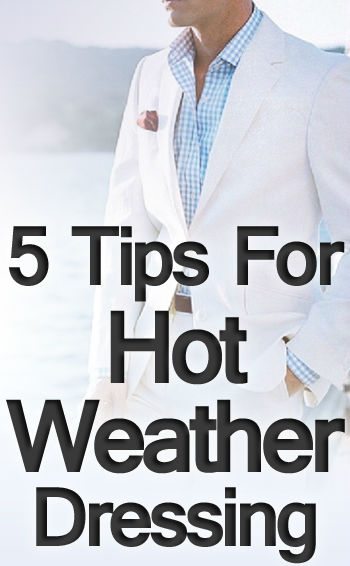
Summer always comes with a relaxed and laid-back vibe.
When the temperatures start to rise – men everywhere start dressing like they’re off to the beach.
The temptation to dress in shorts and t-shirts with flip-flops is strong.
Which is cool for casual days at the beach or in your back yard – but what about when you go out to meet people?
Gentlemen – the rise in temperature is no excuse to let down your sartorial standards.
Instead of using the summer heat as an excuse to relax your dress code – see it as an opportunity to incorporate color, new fabrics and styles into your wardrobe.
I have readers sending me emails from all over the world – from hot climates like South Africa, India, Australia, and… South Texas, where the temperature get HOT.
A common question from tropical countries is, “I want to dress sharp and take your advice but it’s hot and I can’t wear a jacket – it’s much easier to slip into shorts and a t-shirt.”
It is possible to be stylish in warm weather?
With the help of the five principles and the clothing items listed below – your style will be relevant and smart for the summer months.
These principles apply in climates where the sun is unrelenting throughout the year and to every single item in your wardrobe.
Ready? Let’s get started with the basics – selecting the right fabrics for hot weather.
https://www.youtube.com/watch?v=XX7IH9FWcuA
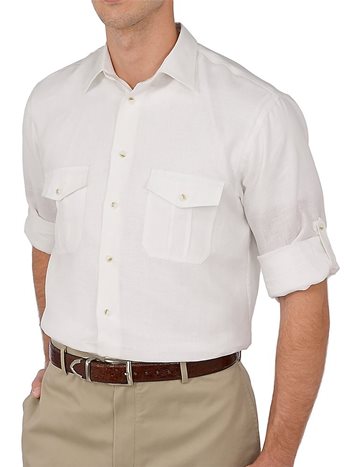
1. Choose Lightweight Clothing And Fabrics To Stay Cool In The Heat
As a general rule – the best fabrics for tropical climates are lightweight and made from natural materials such as cotton or linen.
- Feel the weight of the cloth – is should feel light.
- Hold it up to light – if you can see through it a bit – that’s a good sign.
- Natural, light fabrics tend to dry faster – a bonus when you sweat.
- Lightweight 100% wool is a great option too. There is a general misconception that wool is better in winter. Lighter weaves of wool are suited for hot weather.
Instead of wearing heavier versions of cotton – such as twill, which is what your jeans are made of – opt for poplin, seersucker and madras cotton. Broadcloth cotton dress shirts will be cooler than dress shirts made with the heavier oxford weaves.
Innovations with lightweight synthetic fabrics have come a long way. Synthetic fabrics are suited for performance gear. If you are buying a dress shirt or jacket made from these fabrics – ensure that the garment is specifically engineered for hot weather.
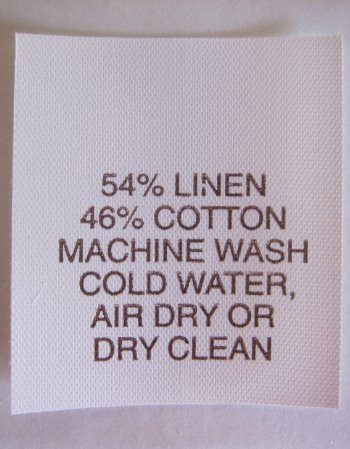
2. Breathable Fabrics Are Best For Hot Weather
High temperatures combined with high humidity can make life uncomfortable – especially for people not used to tropical conditions.
Humans maintain a cool body temperature by perspiring heat away from the body.
It is important to allow air circulation to maintain a cool body temperature.
Fabrics for hot climates should maximize the flow of air through the clothing, allowing heat and moist air to escape.
The fabrics should be breathable.
Fabrics that trap moisture tend to create unpleasant odors.
Natural fibers are generally better at soaking up moisture from the skin and allowing it to evaporate from the outer surface.
Cotton is extremely comfortable and allows your body to breathe with ease. It absorbs excess sweat. Linen and other natural fibers also breathe and are good at absorbing moisture.
These fabrics tend to breathe more than synthetics such as polyester.
Just because a fabric is lightweight does not guarantee that it is breathable – a trash bag is lightweight but not breathable.
Some fabrics trap heat by creating an insulating layer over the skin. Synthetic and fabrics that are of thicker weaves tend to reflect heat back to the body and inhibit the outward flow of warm, moist air.
Synthetic fibers tend to be water-repellent; they allow sweat to build up, reducing evaporation, and causing discomfort and irritation.
Silk is not a good choice as it tends to retain heat. Silk can lose some of its strength through exposure to strong sunlight and perspiration.
With its natural ability to breathe, wool is better than polyester fabrics – especially in tropical weight wool suits.
Comments
-
Step 1 im not dressing like a ?
i aint even read though
lemme guess linens.. capris all white.. canvas shoes.. foh -
5 Principles for Hot Weather Clothing | How to Dress Cool in Warm Weather | Dressing For The Heat Pt. II
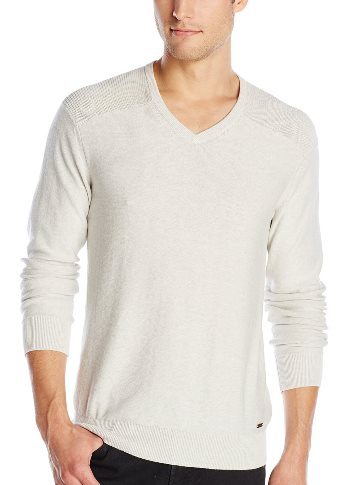
3. Clothes That Offer Protection Are Better In Summer
While it is important to look your stylish best in the heat – protection from the sun’s harmful UV (ultraviolet) rays should be a priority.
Clothing is the most basic form of protection against the sun.
The more skin covered – the better. Long pants cover better than shorts. Long sleeved shirts are better than t-shirts.
A walk of an hour or more will give you lots of sun exposure on your head, shoulders, neck, back and cleavage.
Hats protect your head from the sun.
Wearing a hat means you’re going to keep more of your hair – the protection from the sun’s rays
Read more about it here.
Long sleeve shirts –
Polo t-shirts don’t cover your arms and short-sleeved henleys leave your upper chest exposed to the sun. Opt for long sleeves and t-shirts that cover the sensitive area at the base of your neck.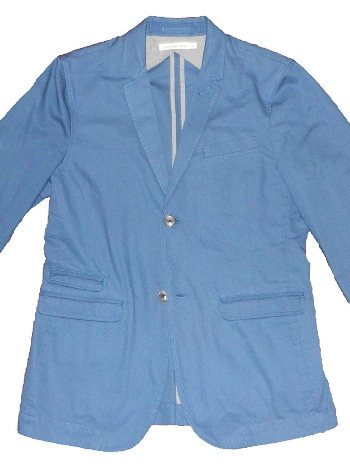
4. The Construction Of Your Clothes Is Crucial In Hot Weather
The construction of a garment – the way it is made – is just as important as picking the right fabric for men’s clothes in hot weather.
The lightweight and breathable properties of a fabric can be rendered useless if the garment is constructed in a way that doesn’t emphasize these properties.
A polyester lining on a 100% lightweight wool jacket restricts the breathability of the wool – making it a poor option for hot climates.
Blazers are usually lined with polyester, satin or silk – none of which breathe well. This traps heat in the layer between the fabric and the lining.
Unlined blazers or half-lined jackets are your best options in the summer months.
You have the option of slimming the bulk on your blazer by opting for one without an inner lining.
A felt hat has holes making to allow air circulation…
Loafers with holes.
A looser fit on clothes helps in the circulation of air. Baggy or oversized won’t look flattering – a linen shirt fitted slightly looser than a dress shirt will keep you feeling breezy.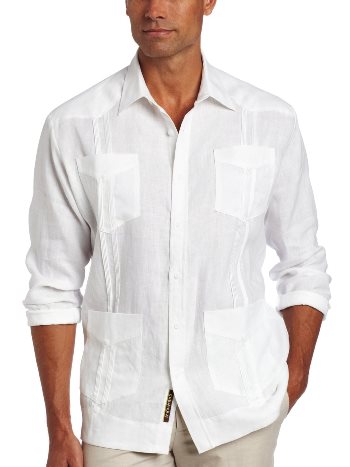
5. Lighter Color Clothes Are More Suited For Hot Weather
Basic physics – dark colors absorb more light. Therefore they are going to be hotter.
Light colors reflect light – making them cooler to wear in the summer.
Dark shades of blue, purple and green generate thermal energy when exposed to intense sunlight. Lighter colors generate less thermal energy under the same sunlight conditions.
Light reacts to colors in different ways, depending on how much is absorbed or reflected.
Since black naturally absorbs more light that it reflects, more consequent heat is retained. Light reflects more off of white than is absorbed, so white retains less heat.
Since people associate the summer time with sunshine and heat, light-colored clothing may enhance moods in keeping with the season.
Perhaps fashion designers traditionally produce summer season collections in shades of white, beige, pink, and yellow, and people seeking to appear fashionable follow those trends.
Whites, baby blues, grays, creams, yellows and tans will keep you feeling cooler than blacks, navy blues, or any other dark colors.
Brighter colors will also make you easy to spot in a crowd. Take advantage of the bright weather and rock some color….
Clothing Items Recommended That Will Keep You Looking Cool In Hot Weather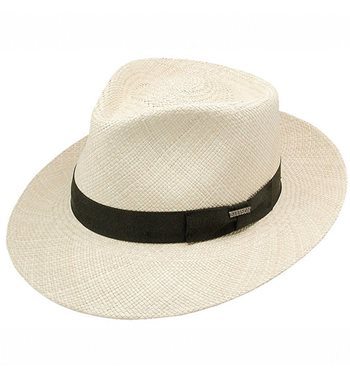
Straw & Felt Hats Provide Protection
Hats are a classic and stylish option for men to protect their head and face from the sun.
Body heat escapes most easily from the head – you want that heat to escape while protecting your head from the sun’s rays.
A wide-brimmed straw or felt hat is lightweight and is constructed to allow air circulation through the venting holes on the sides of the hat.
Summer Jackets Must Be Lined Properly
An unlined or half-lined hopsack jacket is lightweight, breathable and appropriate for summer.
A lightweight and light colored suit in cotton, linen or tropical wools works well in the heat – linen wicks away moisture from your body keeping you breezy.
Ensure that the lining of your jacket is breathable.
If you want to step it up a notch – pair a knitted necktie and colorful pocket square with your jacket.
Linen Shirts Will Keep You Cool In Hot Weather
Linen shirts are lightweight and comfortable. The only drawback is the amount of ironing necessary.
For cotton shirts – stick with 100% cotton and lightweight fabrics. Oxford cotton is a heavier fabric and if you have a choice between plain and twill – opt for plain cotton rather than a tightly knitted twill.
Herringbone is a poor choice for summer. Although it is a lightweight cotton fabric – it is not breathable.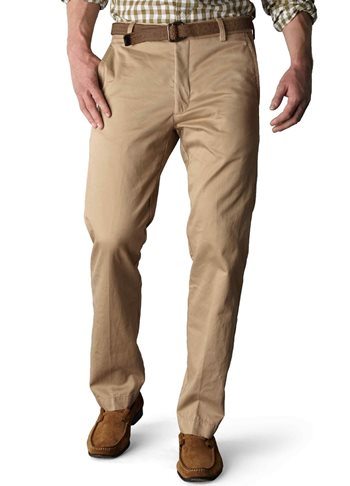
Trousers – Skip The Jeans And Choose Chinos For Summer
Despite the popularity of jeans in any weather – they are a poor choice in the summer.
If you are still keen on wearing jeans – stick with lightweight jeans like the ones made from high quality supima cotton available at Buckley Denim.
What’s the alternative? 100% cotton chinos in different colors. Roll up the bottom, air circulates – loafers, have fun.
Tropical weight wool and linen trousers highly recommended. Requires ironing but looks sharp and is COOL.
Shorts are an overplayed and easy option for summer. Click here to read my article on how to look stylish in shorts.
Shoes & The Summer Heat
Going without socks is a summer look – but be careful because there are enough sweat glands in your feet to produce and fill a quarter cup with moisture every day. All that moisture stuck in your shoes can ruin the leather.
For hot weather – I prefer lightweight slip-ons from Paul Evans or moccasins from Jay Butler.
Wear shoes that are breathable along with lightweight cotton or wool socks in fun and bright colors. Other options are boat shoes and driving shoes worn with hidden socks. This is definitely not the season for boots.
Sandals are acceptable for social events, but flip-flops are strictly for the beach.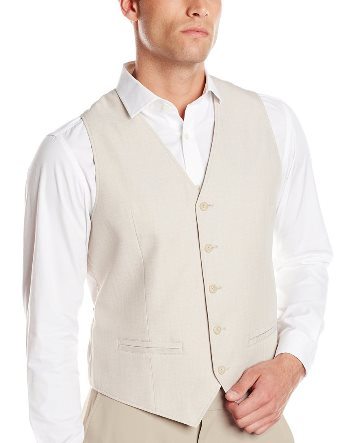
Vest Or Waistcoat For Summer Formals
A vest (or waistcoat in other parts of the world) is the summer equivalent of a formal jacket. With a breathable inner lining – vests are your best option to layer your outfit in hot weather.
You could choose to leave the jacket out of a three-piece suit and wear a waistcoat with a bow-tie or a necktie and roll up your shirt sleeves. A cotton or linen waistcoat will complement your chinos and add extra color to your outfits.
In hot weather – being comfortable is a priority. But with the right mix of colorful, lightweight and breathable fabrics, constructed with the right elements – you won’t have to sacrifice style for comfort.
It is possible to get a good mix of both – classic style is timeless and not restricted to seasons either.
-
I can dig the light colors idea.
-
playmaker88 wrote: »Step 1 im not dressing like a ?
i aint even read though
lemme guess linens.. capris all white.. canvas shoes.. foh
Huh? -
playmaker88 wrote: »Step 1 im not dressing like a ?
i aint even read though
lemme guess linens.. capris all white.. canvas shoes.. foh
Maybe you should read the article, you stupid ? . -
who writes this BS, they need to be fired
-
Hot Weather Jeans | Jean Alternatives In Summer | Wearing Denim In Hot Temperatures
http://www.realmenrealstyle.com/hot-weather-jeans/
hot weather jeans buckley denim
Jeans in summer?
Not always recommended – especially when the temperature climbs above 90 and it’s humid outside.
Having lived in Corpus Christie, Texas & Pensacola, Florida…….I learned quickly as a young man that jeans are not always comfortable.
So what are your options?
Should you give up jeans this summer?
Is there a way to wear denim in hot weather without sweating your ? off?
Well yes – there is!
FYI – the images and information in this article are courtesy of Buckley Denim.
Buckley Denim (founded by my friend Jim Buckley) specializes in lightweight hot weather denim.
The video below is a great summary – and I actually go into points I do not cover in this article!https://www.youtube.com/watch?v=lx3mGkRe_Tg&index=5&list=PLbAUemeg-KyeFiPygfaFMMkUePK-ooy8O
Big Tip: Choose The Right Fabric Weight
If you’re buying from someone that knows what they’re talking about, you can get pretty technical with your jeans.
In big box stores, this isn’t so much of an option (it’s one good reason to seek out a custom or boutique jeans maker, rather than a large retail brand).
But if you get the chance, a little research can go a long way toward picking out jeans that are going to stay comfortable even in the heat of summer.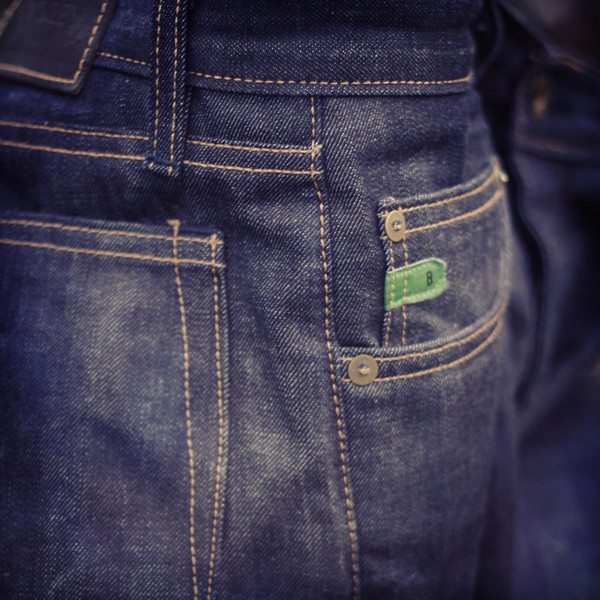
Denim Weight
First things first, take a look at what your denim weighs. Denim is measured in ounces, like most textiles used in clothing. It’s usually much heavier than wool or finer cotton weaves. That gives it sturdiness, but also makes it warmer in the summer.
Traditional denim jeans usually use cloth that weighs between 12 and 16 ounces per yard. That’s thick enough to be tough, but not too stiff.
Anything above 16 oz. is getting into one of two niche markets: truly rugged work-wear for men who punish their jeans severely, and monstrously thick “raw denim” designed to fade and crease in dramatic patterns. You don’t want to wear either of them in hot weather if you can help it.
Below 12 oz., on the other hand, you’re looking at jeans that can actually feel better than some khakis and chinos in the summer. Denim is a fairly breathable weave. Trousers in a very tight cotton weave can actually be more stifling than jeans made from denim an ounce or two heavier, simply because of the airflow.
Denim Blends and Treatments
Serious denim fans will talk for hours about the different ways to weave raw bolts of denim cloth.
You don’t need to know quite that much, but there are a couple things worth keeping in mind for your summer wear.
First off, keep it 100% cotton. Summer is not the time for “stretch denim.” The synthetics that make denim stretchier don’t breathe the way cotton fibers do, making the jeans more prone to trapping sweat and hot air against your skin. Summer’s also a time when you want looser, breezier fits that allow a little airflow, and if you’re wearing your jeans comfortably loose they don’t need to be stretch denim anyway.
Second, pay attention to how the denim was treated. “Raw” or “dry” denim, in which the cloth is not washed after its dying, will be stiffer and less breathable until broken in. On the opposite end of the scale “distressed” denim that’s worn through in patches will obviously give you the most airflow.
For most men, the happy medium is in between: lightweight denim that’s been washed before wear. If possible, break it in while the weather is still cool, so that you don’t have any stiffness fighting you in the hot and humid months. Unless you’re going for a specific look, there’s no reason to go out of your way for either raw or distressed jeans.
Tips On How to Wear Denim in the Heat
So have you got yourself a nice pair of well-washed, broken-in, less-than-12-oz.-denim jeans?
Awesome.
Here’s how to wear them: with other light clothing and not too many layers.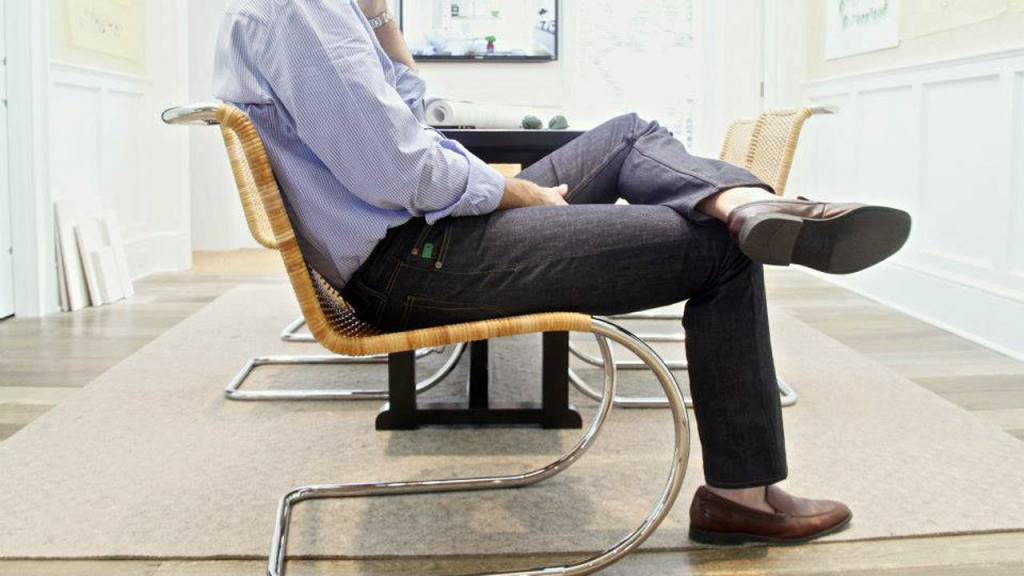
Rolled Cuffs – Yes Or No?
Rolling your cuffs in the summer is totally acceptable when you’re just bumming around. If you go into a sit-down restaurant or anywhere more formal than that, roll them down, but on the street or the beach or whatever the roll is fine.
It’s a particularly popular style with guys who buy selvedge denim, as selvedge jeans tend to leave the distinctive colored stripe of the cloth’s edge visible on the underside of the cuff. You’ll see some very careful rolls designed to flaunt those if you watch fashionably-dressed young guys in the summer.
A simple rule for cuffs and footwear, though: if you’re rolling the cuffs, no socks. Wear slip on shoe styles like boaters or sandals.
Jeans with the cuffs worn down can be worn without socks as well, but generally look better if you’ve got a sturdier shoe and a pair of socks.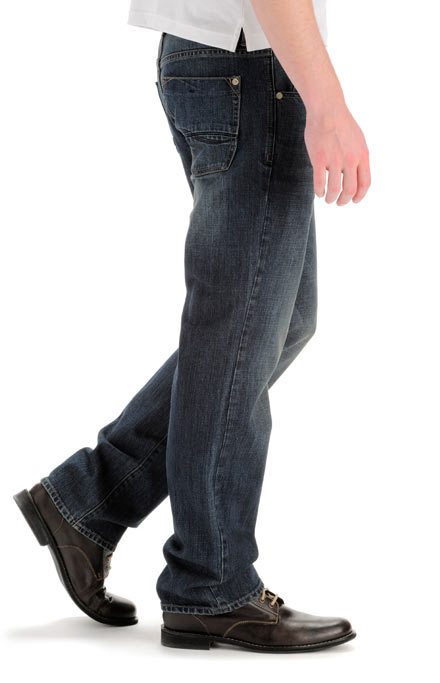
Matching Your Jeans With Shirts
Jeans go with most things that aren’t more denim.
In the summer, plain old jeans and a T-shirt works fine. It’s about as casual a look as you can get, so don’t expect to start any new fashion trends, but it serves its purpose. To keep it classic, go with a tight-fitted white T-shirt and sturdy work shoes or boots — if it was good enough for Marlon Brando, it’s good enough for you.
Other good options include henleys and polos (similar to T-shirts, but they show a touch more style), light long-sleeve crew-necks, and casual dress shirts of both the long- and short-sleeved variety.
Most of these are worn un-tucked. At the point where you’re somewhere formal enough that you need to tuck your shirt it, you might as well wear a different sort of lightweight summer trousers — chinos, seersucker, etc. — and leave the jeans at home. They’re for casual summer street wear, not office potlucks at the picnic shelter.
Matching Denim With Hot Weather Footwear
Ok, so your jeans are rolled and you have on a hot weather collared shirt. What to wear on your feet?
Sandals – yes, I know many of you all hate them. But I find a well made, leather pair feel great in the summer. Just make sure your feet are clean and your toenails don’t look like claws from a science fiction horror movie. Seriously – good grooming habits here gents. You don’t have to get a pedicure but this isn’t the time to show the world your inability to cut your nails.
Slip-on casual shoes, from boat shoes to espadrilles to something dressier like a double-strapped monk. I wear my slip on Sperry boat shoes without socks – but I do clean them and if you expect to walk across Manhattan in the summer consider an invisible sock for comfort and making sure your shoes aren’t ruined by drenching in sweat.
-
king hassan wrote: »playmaker88 wrote: »Step 1 im not dressing like a ?
i aint even read though
lemme guess linens.. capris all white.. canvas shoes.. foh
Huh?
My bad lol.. -
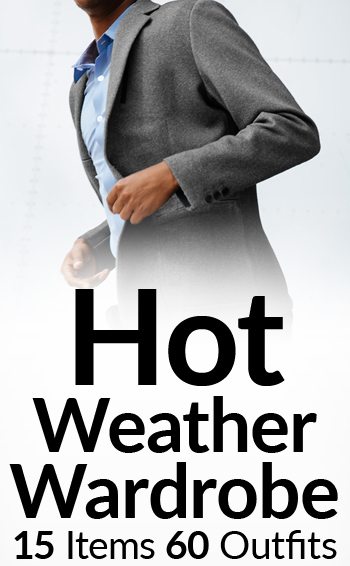
http://www.realmenrealstyle.com/dress-sharp-heat/
Summer is coming.
But you still have to dress up.
The winter wool suits soak up sweat like a sponge.
How can you still retain the formality you need and beat the heat?
Though summer is synonymous with leisure, fun, and ease, it can be a difficult time during for menswear.
Remaining stylish while staying cool is more of a science than art.
It requires different fabrics, knits, and blends. It can get overwhelming.
Here are some tools that will help you stay as cool as possible without diminishing style.https://www.youtube.com/watch?v=_V3FwHiQisQ
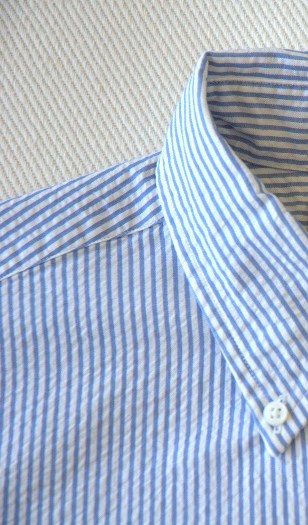
What Fabrics Are Best For Hot Weather?
Lightweight Breathable Cotton
As it relates to clothing, Egyptian cotton, and Australian cotton are known to be of the highest quality in the world.
There are dozens of different types of cotton but what’s most important is the way in which they are constructed in your garment. What you want to know is if it’s woven or knitted.
Knitted cotton is what’s usually found in sweaters. The knits of the fabric are closer together and not as stretchy. This allows less air to flow through the fabric thus keeping body heat in.
Woven cotton is the exact opposite. Its construction is a bit more loose with wider gaps between strands. These gaps allow more breathability. The air can travel through the fabric easier thus releasing heat.
An additional benefit of woven cotton is its elasticity. Because it’s construction is looser, the fabric stretches more. This is great for comfort, especially in the hot summers.
Common examples of lightweight cotton include:
Seersucker – Probably the lightest cotton weave, seersucker is slow and expensive to produce but very comfortable. It has a much more distinctive dimple pattern than poplin, giving it a wrinkled appearance.
Seersucker is used for shirts (usually short-sleeved), trousers, and suits, though the latter are usually not seen outside the United States.
Poplin – Poplin has a faint dimpled texture that comes from using two different sizes of threads in the weave. The dimples make tiny air pockets, making the garment much more breathable and faster-drying than a flat weave. Poplin is a common choice for higher-end polo shirts and summer dress shirts.
My recommendation is to make sure that your cotton shirts are woven. A 100% cotton shirt with a tight weave such a knit is not the way to go in the summer. Cotton is very absorbent. When you sweat during the summer that moisture will absorb into the fibers. Because a tightly woven shirt doesn’t give as much and holds in heat, will literally be wearing a sweat box.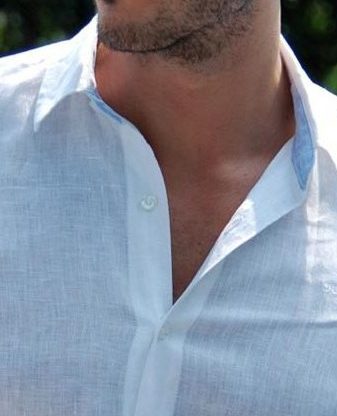
Linen
Linen is a summertime favorite. It’s made from the flax plant and is widely heralded for its exceptional coolness and freshness in hot weather.
It’s a durable textile that’s twice as strong as cotton. It’s a good absorbent of prints and dyes. Its elasticity is lacking and known to wrinkle easily. The wrinkle effect may be a turn off to some but I think it adds to the character of the fabric.
Another great characteristic of linen is that it resistant to damage from abrasions. It also doesn’t retain moisture. This fact comes in handy when sweating during the blistering summer heat.
Linen is the fabric that will allow you to remain the coolest in the summer months. It’s usually used in more of a casual or leisurely look but there are some great linen suits that will keep you stylish and cool.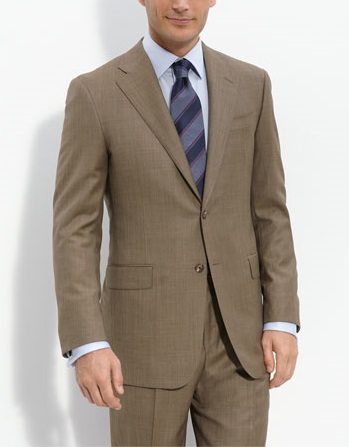
Worsted Wool
Now I know that you’re thinking wool is for winter or at least for cooler temperatures.
As a generalization you’re correct. There are, however, some tropical weight wools available. It’s considered tropical because it’s worsted (medium weight) yarn.
This type of porous weave aids in the breathability of the fabric. It also has a degree of wrinkle resistance. One such example is lightweight Fresco.
In addition to understanding and using fabrics, there are some nuanced styling tips that will help you remain cooler in the summer.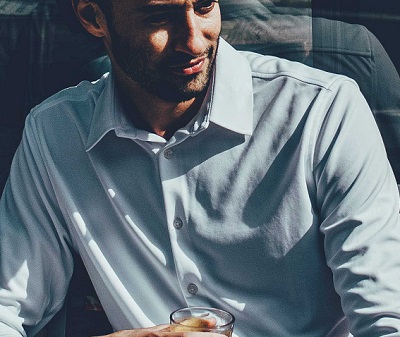
Synthetic Fibers
Now is where we start getting into sweat wicking material.
Synthetic fibers do a great job of allowing moisture out of the body (like sweat) while still blocking moisture from entering (like rain). The most common synthetic material to look for is polyester.
The benefits of a synthetic fiber includes:- Moisture Wicking
- Lightweight
- Easy to Clean
- Dry Fast
Look for a company that incorporates synthetic blends into their dress shirts to retain formality while still keeping you cool in the heat.
Along with knowing the right fabrics to sport during hot months, you have to know how to build your wardrobe. It’s imperative that you know what pieces work best and an interchangeable wardrobe will do just that!
An interchangeable wardrobe has a few pieces that can be mixed and matched to create many different outfits. The advantages of having this kind of wardrobe is that its- Cost effective
- Saves time
- Practical
-
15 Item Hot Weather Wardrobe
http://www.realmenrealstyle.com/dress-sharp-heat/
Hot Weather Polo Shirts (Two)
Navy and white are the choices due to versatility. Navy and white are the suggestions because of their versatility. It’s a great shirt for dressing up and down. A polo can be worn at the office, on the golf course, or traveling during summer vacation. The shirt has a woven construction which maximizes breathability and comfort.
It also can be worn in a few different aesthetics:
Business casual – wear with a suit or with just trousers/chinos
Causal – wear with Jeans or shorts
One Belt
Your belt should be made with quality leather that can handle many wears. It should match also pay attention to the buckle.
Make sure that it’s the same metal as your favorite watch and other accessories. This continuity is a great style element.
If you decide to bring different color shoes, try making it a reversible belt. If the shoes are gray, it’s not an issue because gray is a non-color and can match with black and brown belts.
Business Hot Weather Wardrobe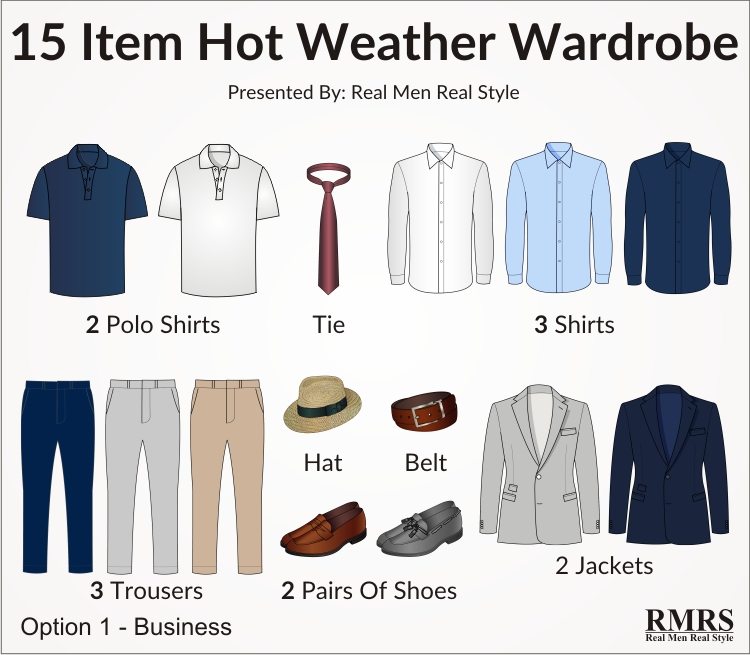

Breathable Dress Shirts (Three)
It is the summer but we still have to go to work and other semi-formal or formal events. As such we can’t neglect the dress shirt.
You should stick with the basic colors: white, navy, and light blue. These colors are neutrals that will work with any pair of pants and blazer that you have.
Your neckties will work well with them too. It’s important that you pay attention to the fabric and construction that was mentioned earlier in the article.
There are a number of different types of dress shirts but the ones that will work best in the summer months are:
- Broadcloth/poplin – Generally thinner and lighter fabric that’s tightly woven with a smoother wear
- End-on-end broadcloth – Woven with white and color thread giving off a great texture and color combination.
- Seersucker – Woven with a puckered (raised) look that promotes air flow.
- Sweat-Wicking Polyester – Polyester does a good job of wicking away sweat rather than absorbing, showing those embarrassing pit stains.
The main thing is to make sure that the shirts are woven and not knitted. Woven shirts will allow you body to ventilate more that knitted shirts.
Another additional trick to remain professional while cooling off is to roll the sleeves of your shirt up. This is much more professional than a short sleeved shirt.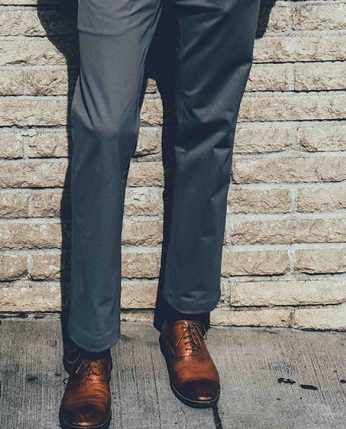
Lightweight Trousers (Three)
Your trousers should be neutral. Navy, gray, and khaki are perfect for the summer months. The construction of them should be sturdy yet breathable. Worsted wool trousers have a stellar aesthetic and will help you stay dry. Linen is a great option too but its generally reserved for very casual environments.
Chinos are perfect for hot weather. as well Especially if they are lightweight and sweat-wicking. However, lightweight cotton or any of the fabrics mentioned above works great too.
Roll up the bottoms for better air circulation, slip on some loafers, and stay cool and stylish. Shorts are an overplayed and easy option for summer as well.
Stay away from seersucker for the purposes of interchangeability. The textured and patterned fabric are too noticeable and won’t allow multiple wears in a short amount of time.
Remember that jeans are a poor choice for summer. They’re heavy, hold in moisture, and formal jeans are dark colored (which means they absorb the heat).
A Pair of Shorts
Shorts are the obvious choice when it comes to hot weather, yet many men stray away from wearing them. The purpose of having shorts in this wardrobe is to round it out by completing its versatility. Shorts can be paired with a polo or a long sleeved button down. Shorts give you a completely casual look.
Still follow the rules about fabric when purchasing and wearing shorts as that will make you even cooler. When it comes to length of shorts, wear what’s comfortable. A general rule is to have the shorts stop at your knee.
I also want to provide you with some other style tips that can help you as you stylishly fight the hot months.
Casual Hot Weather Wardrobe[size]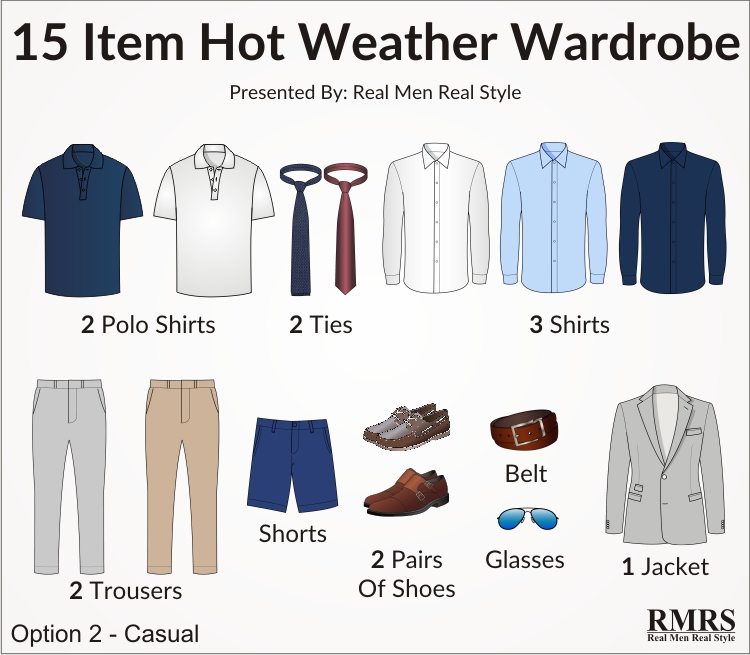
One Pair of Sunglasses
It’s hot and sunny so you need to protect your eyes. Again, ensure that the frames are the same metal as all other metals in your outfit. There are dozens of styles of sunglasses and varying price points. Try on as many as you can until you find the stylish pair that’s right for you.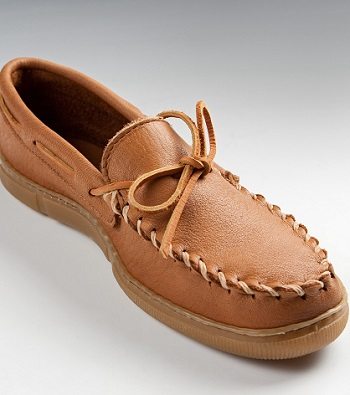
Two Pairs of Shoes
Summer style is a lot less formal so brown shoes work well. Loafers and double monk strap shoes are summer time favorites as they are stylish and comfortable. Notice that they are slip-on shoes and not lace ups.
During the hot months, no show socks are acceptable and if you want to roll up your pant leg to show some ankle, it looks better with a slip on shoe.
There are other options that will allow you to remain stylish while sporting a bevy of different looks.
Moccasins – Moccasins are usually made with a softer, more pliable leather. They are usually worn with casual looks such as jeans and a sports coat or chinos and a pique polo. They can be paired with a suit but because it’s a casual shoe, don’t wear a necktie.
Canvas sneakers – The canvas material is very breathable. Wear these with jeans, shorts or chinos.
Boat shoes/topsiders – These are made with lightweight suede, leather, or canvas material. They are for casual looks only. Wear them with jeans, shorts, or khakis.
-
Unstructured & Breathable Jacket (One to Two)
http://www.realmenrealstyle.com/dress-sharp-heat/
Guys, it’s hot and jackets are layers. One jacket is sufficient and should be a lighter color. I suggest gray as it will work well with the trousers and shirts. The type of jacket that’s going to keep you dapper and professional while helping you stay cool is an unconstructed jacket/blazer.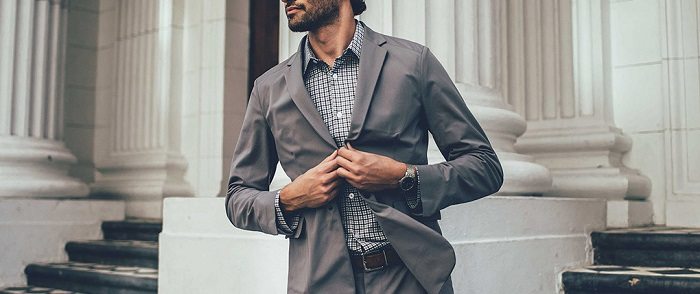
A soft, deconstructed or unconstructed jacket is one that has:- no canvas
- no fusing
- little or no padding
- no lining except in the shoulder and through the sleeve
- no roping.
It’s generally made from cotton, linen, or polyester. All of these elements are so the blazer can be breathable.
Two Neckties
A navy tie and a crimson or burgundy tie would fair well during these months. They are standard colors that work all year and will look great in the office or on a date night
Consider two different styles of ties so that you can spice up your look. Also, make sure that each tie is made from a breathable fabric like woven cotton or linen. Remember, the goal is to stay sharp and cool.
Versatile Hot Weather Wardrobe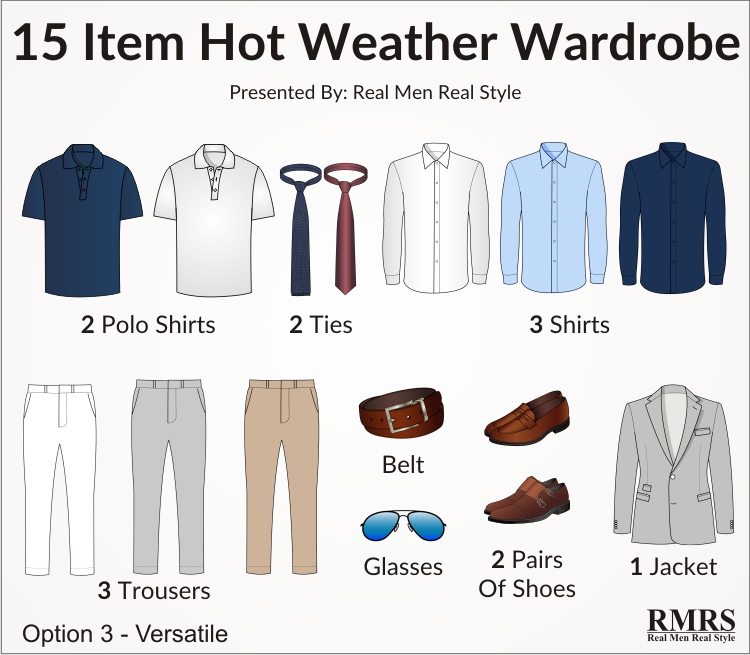
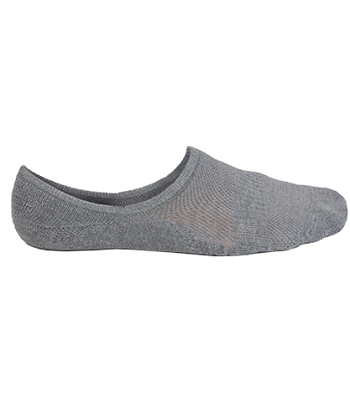
3 Hot Weather BONUS TIPS
1. Breathable No-Show Socks
Wool dress socks become a heat magnet in the summertime. Of course, going sockless can ruin the soles of your shoes, and create a sticky and uncomfortable feeling throughout your day.
The happy medium to get the sockless look you want and still stay cool is the no-show sock. They keep your legs cool since there are no knee high dress socks under your pants.
Ideally, you want a no-show sock that is breathable. This way moisture can escape as air passes through, to keep your feet from locking in sweat all day. This is done with synthetic fiber and cotton blends in the socks. This way it retains comfort and function at the same time.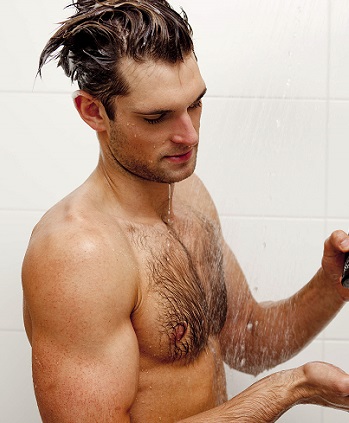
2. Maintaining Your Hygiene
Again, this may seem to be a common sense item on the list but let’s refresh ourselves nonetheless. As me,n our days are often filled with rigorous activity. As such we must make sure that we are dry.
Use an antiperspirant versus as regular deodorant. An antiperspirant will help to manage sweating as well as provide a great scent. Sweat control is needed during the sweaty and heat-filled months.
Another thing to consider is lotion. Purchase and use a lotion that has sunblock in it and use it on all parts of your body regardless if it is exposed to the sun or not. Keeping healthy and moisturized skin is just as important as what’s covering your skin.
3. Light Colors Are your Friend
Basic physics – dark colors absorb more light. Therefore, they are going to be hotter.
Light colors reflect light – making them cooler to wear in the summer.
Dark shades of blue, purple and green generate thermal energy when exposed to intense sunlight. Lighter colors generate less thermal energy under the same sunlight conditions.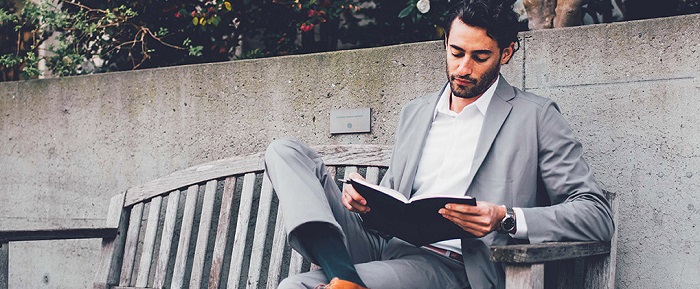
Light reacts to colors in different ways, depending on how much is absorbed or reflected.
Light colors to wear are:
- White
- Baby Blue
- Light Gray
- Tan
- Cream
-





